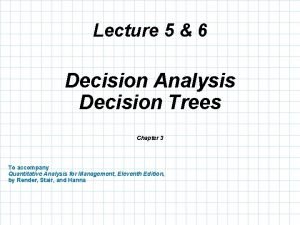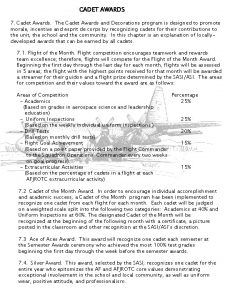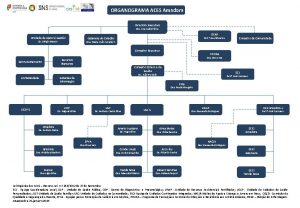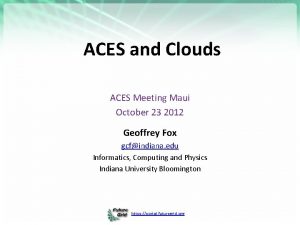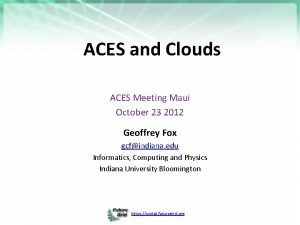Theory of Aces M V Simkin V P










- Slides: 10

Theory of Aces M. V. Simkin, V. P. Roychowdhury, Journal of Mathematical Sociology, v. 30, no. 1, pp 33 - 42 (2006)

Achievement = number of opponent aircraft shot down (number of victories) Fame grows exponentially with achievement Fame = number of web pages mentioning the ace (number of Google hits) The correlation coefficient between achievement and the logarithm of fame is 0. 72. The correlation between achievement and fame (without logarithm) is only 0. 48. This means that on the average fame grows exponentially with achievement and about half of difference in fame is determined by difference in achievement. A scatter plot of fame versus achievement for 392 German WWI aces.

Achievement is distributed exponentially, while fame has a power law tail The distributions of achievement (number of victories) and fame (number of Google hits) obtained using the data for 392 German WWI aces.

Theory of fame When the distribution of achievement, A, is exponential: and fame, F, grows exponentially with achievement: then fame is distributed according to a power law: ; A cumulative advantage model with multiplicative fitness could explain why fame grows exponentially with achievement.

Unknown aces or fame is unfair All 392 German WWI aces together achieved 5050 victories and got 17, 674 Google hits (as of 2004). Manfred von Richthofen (The Red Baron) with 80 Victories and 4, 720 Google hits accumulated of fame when he shoot down only of opponent aircraft. 60 lowest scoring aces together achieved 300 victories or destroyed of the opponent aircraft, but together got only 463 Google hits or fame. of

Sometimes fame is even less deserved von Lemming wrote: This one seems to be more along the lines of what you are after: From Google: Searched the web for "mikhail simkin". Results 1 - 10 of about 352. Search took 0. 19 seconds Mikhail Simkin replies: 352 Google hits for "Mikhail Simkin". According to Theory of Aces to achieve such level of fame an average WWI ace had to down over forty opponent aircraft. What can I come up with to justify such number of Google hits in my case? A private pilot license; 203. 5 hrs total flight time; Cessna 152/172, Piper Cherokee. Not a single combat mission. Shame. Nothing, but shame.

Chess players’ fame versus their merit M. V. Simkin, V. P. Roychowdhury, Applied Economics Letters 22(18): 1499 -1504, 2015 Elo rating Distribution of player strength, S Probability that the player of average strength wins over the player of average strength is Elo rating of 371 international chess titles holders born between 1901 and 1943 versus their fame, measured as the number of Google hits.

The correlation coefficient between merit and fame is 0. 38 ( ). The correlation between merit and the logarithm of fame is 0. 61 ( ). Exponential growth of fame with achievement leads to its unfair distribution. Mikhail Botvinnik has a merit figure of 0. 80, which is only 6% below the merit figure of Robert Fischer, which is 0. 85. However Botvinnik’s fame measures 173, 000 Google hits, which is 7 times less than Fisher’s fame of 1, 260, 000. At the bottom of the list is a chess player with a merit of 0. 19. This is 4. 5 times less than Fishers’ merit. However his fame figure of 76 is 17 thousand times less than Fishers’ fame. Fame (number of Google hits) of 371 international chess titles holders versus their merit (expected score in a game with a randomly selected player).

Estimating achievement from fame M. V. Simkin, V. P. Roychowdhury, Significance 8 (2011) 22 -26 M. V. Simkin, V. P. Roychowdhury, Journal of Statistical Physics: Volume 151, Issue 1 (2013), Page 319 -328 For aces With 50% probability estimated achievement is between 0. 7 and 1. 44 of the real achievement. With 95% probability, estimated achievement is between 0. 43 and 2. 4 of real achievement. With the 85% probability the real achievement is between two times more and two times less than the estimate.

Nobel Prize winning physicist Lev Landau classified theoretical physicists according to their achievement using a logarithmic scale. According to his ranking system, a member of the lower class achieved ten times less than a member of the preceding class. He placed Einstein in ½ class. In the 1 st class he placed Bohr, Schrödinger, Heisenberg, Dirac, Fermi, and de Broglie. Thus, he thought that Einstein contributed to Physics times more than Dirac or Schrödinger. This is close enough to our estimate, according to which Einstein achieved 2 times more than Dirac or Schrödinger. Note that Landau’s ranking is incomparably closer to our estimate than to a naïve estimate equating fame and achievement. The agreement becomes worse in the cases of Heisenberg and Bohr where we estimate that they achieved 0. 6 and 0. 7 Einsteins respectively. However, earlier in his life, during 1930 s, Landau used another classification. According to it Lorentz, Planck, Einstein, Bohr, Heisenberg, Schrödinger, Dirac all belonged to the 1 st class. Our results are compatible with this earlier Landau’s classification.
